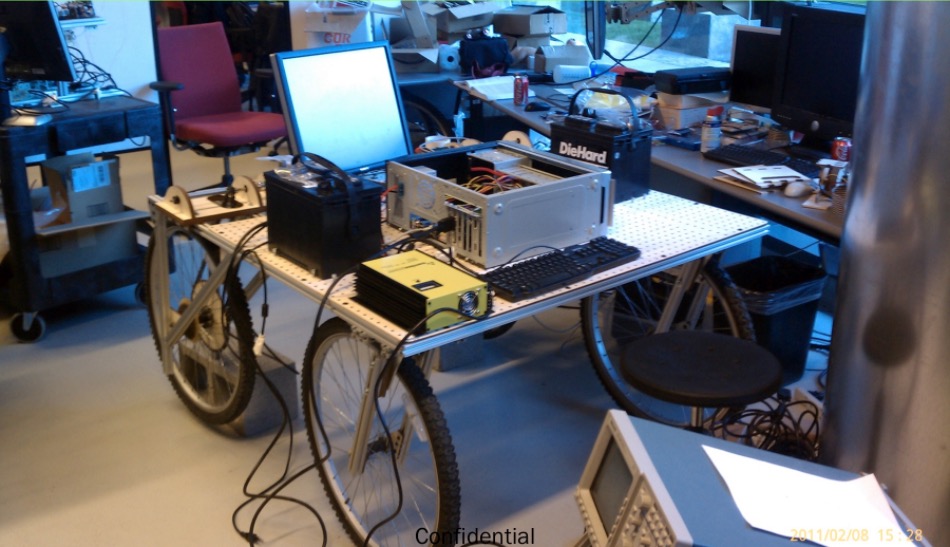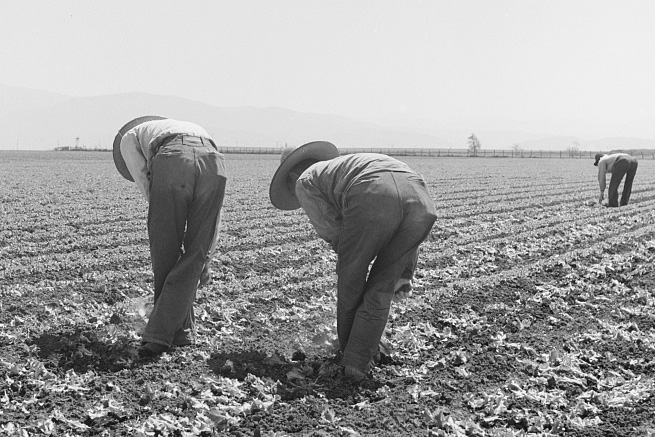Before Blue River brought its market-leading agricultural robot to market, its founders planned to build an autonomous lawnmower.
When co-founders Jorge Heraud and Lee Redden first pitched this idea in front of Steve Blank’s Launchpad class at Stanford, Blank was sitting in the back, quietly laughing to himself.
“We knew that no one was going to spend tens-of-thousands of dollars to automate one person’s job,” Blank says, “It was a bad idea, but we couldn’t tell them that. They had to learn that on their own.”
Thankfully, learning that your initial idea is terrible was in many ways the point.
Over 10 weeks, Blank’s class — which Blank teaches at both Stanford and Berkeley — walks its students through a practical implementation of his famous lean methodology.
Roughly, this means students:
- Come up with concept for a product
- List out all of their core assumptions about the market for it
- Go into the market to test those assumptions by talking to potential customers, suppliers, vendors, and technologists.
- Take what they learn and pivot their concept until it resembles something the market wants, keeping lines of communication with customers going at all times.
- Build a minimum viable product
- Get that MVP into customers’ hands as quickly as possible.
The early stage of this process involves building a “Business Model Canvas,” on which you draw a large grid and list out every single core assumption you’re making about your product and the market you’re going to sell it to:
What are you going to be selling? To whom, exactly? What is your value proposition for them? Why would they buy it? Who would be the key partners? What about vendors and suppliers?
On their original canvas, Jorge, Lee, and the rest of team defined a handful of potential market segments that might be interested in a lawnmower that drives itself.
They came up with golf courses, football stadiums, parks and recreation departments, and consumers.
After building out your Business Model Canvas, the next step is customer development. This means talking to potential customers in depth to uncover their most urgent business problems and whether or not they like your proposed solution.
Blue River’s team was cautiously excited and optimistic when they reached out to their network and went out into the world with their autonomous lawnmower idea.
Fortunately, Lee and Jorge are smart guys. They learned pretty fast.
As Lee says, “We went through and interviewed customers in each one of our target segments. Almost everyone immediately said ‘we do not want this product. This is not a good business.’ It was a resounding no.”
The first major benefit of lean startup development had just demonstrated itself: Jorge and Lee discovered that their autonomous lawnmower idea was a bad one before diving headfirst into product development and crashing hard into a market that didn’t exist.
The second major benefit of lean development was just around the corner.
The organic carrot farmer has a problem
One positive side effect of doing customer development is that it puts you in front of a lot of different, well-placed people. If you ask the right questions to these people and listen carefully, you might learn something you didn’t already know.
As part of their customer development process, Jorge and Lee crossed paths with some big farmers and agribusiness execs. Like everyone else they talked to about autonomous lawnmowers, this group was universally unimpressed with the idea.
As Jorge puts it:
“One exec said to us: ‘My tractor costs about $100K, and together with all the other stuff that goes with it, it’s $200–300,000. If your autonomous tractor screws up and sends my machine into a ditch…let’s just say I have very little use for your autonomous tractor.”
But this same exec was happy to talk about his business problems, and he happened to manage automation for a multi-billion dollar agriculture business.
“But,” the he said, “I do have this huge problem with weeds.”
From autonomous lawnmower to robot weed-whacker.
At this moment, Jorge and Lee leaned it.
“The exec said, ‘We’re spending up to a thousand dollars on every single acre for this army of people to go through and clear weeds. They get on their hands and knees and crawl through the field and dig them up, weed by weed.”
Suddenly, as an almost-random byproduct of customer development, the two men had uncovered an expensive, painful problem. They started digging.
Jorge and Lee took a trip down to a big organic carrot farm and watched the weeding process, themselves. Both men were moved by what they saw.
Lee, who grew up in a family of large-scale corn and soybean farmers, put it like this:
“My uncle’s farm is 6,000 acres and six people run the whole thing. Going down to Southern California and seeing all of these people…it blew my mind. It didn’t make any sense. It still doesn’t make any sense! Why the healthy foods we eat — the vegetables — have all this manual labor around them while the crops we turn into ethanol, these commodities, have all this infrastructure that makes producing it extremely easy.
As Lee and Jorge talked to more carrot growers and other large agribusinesses, they discovered that weeds (and the process of removing them) are among the biggest problems these businesses had.
As Jorge says:
“They told us ‘We never have enough labor; the labor we have is undocumented, and at any moment, the policies around undocumented labor could change.’”
Indeed, as many large tomato farmers in Alabama learned the hard way, when government policies suddenly get aggressively hostile to undocumented labor, you can lose an entire season’s crops.
The birth and short life of CarrotBot

So now Jorge and Lee had, through extensive customer development, stumbled across a big, painful problem for organic carrot farmers. They excitedly presented what they’d learned to Steve Blank’s class.
Blank says that when Jorge and Lee and their team presented their findings, Blank told them (in front of everybody) that the were collectively headed for a “B” grade.
The team was stunned. Offended, even.
Weren’t they excelling at the doing the things Blank suggested? Wasn’t their conceptual pivot proof that they’d been implementing the lean framework to perfection?
But, Steve said, “Where’s the MVP?”
According to Steve, this interaction lit a fire under the team. Jorge says he doesn’t remember it at all. One way or another, a prototype got built. Lee remembers this as a very long week.
“From that Wednesday night,” he says, “when we sketched out some rough ideas…to the next Wednesday morning, when we loaded a prototype robot onto a truck and took it down to Southern California, we probably slept a couple hours a night.”
You sometimes hear of a couple of smart software hackers taking a week to throw together a prototype piece of software. It’s more unusual to hear about some smart roboticists taking a week to build a prototype robot.
This prototype robot came with two cameras, two different lasers, and a working LIDAR. They named it “CarrotBot.”
When Jorge and Lee got to Southern California and rolled the CarrotBot out of the truck, the agriculture exec was impressed.
From Carrots to Conventionally-Grown Lettuce
‘By week six of Steve Blank’s 10-week class, Jorge and Lee had completely ditched the autonomous lawn mowing idea. They had met with a range of agriculture executives and independent farmers, built CarrotBot, and reoriented their team towards applying robotics and machine vision to solve problems in agriculture.
But the journey to Blue River’s first commercial product was just beginning. As Lee says:
Our initial focus was on organic carrots, but over the next few months, we kept pivoting. We looked at tomatoes and lettuce and broccoli. We talked to people that made organic fertilizers. We even met with a smaller farmer who grew onions and shallots and actually started work on a robot that could detect shallots at one point.
Eventually, as they developed and tested hypotheses about which markets to enter and which products those markets would need, Jorge and Lee honed in on the problems facing conventional lettuce growers.
Jorge says:
Lettuce turned out to be a very good crop for us to start with. For one thing, it’s harvested year round. For another, you cannot freeze it, you cannot dehydrate it, you cannot can it like tomatoes, and it has a shorter shelf-life.
As much as the team liked the mission of organic crops, they also recognized that as an initial market, it was too small to go after.
“Only about 5–10% of all carrots grown are organic,” Jorge says, “and carrots in general are a relatively small scale vegetable, in terms of acres dedicated to growing them.”
Lettuce on the other hand, is the number-one crop in California, with close to 200,000 acres grown every year. And between farms in Arizona and California, lettuce is harvested every single day.
Meanwhile, there are five big agriculture companies that, between them, control 50% of the entire US lettuce crop.
“Lettuce looked like a great market,” Jorge says. “To have major impact, we didn’t have to go after 100 different customers. We could close five and address 50% of the market.”
And, as Jorge and Lee soon learned, every single one of the players in the lettuce market has a major problem.
The Juicy, Expensive Problem In Conventional Lettuce Farming

The problem every large-scale lettuce farmer faces revolves around something called “thinning.”
In case you’re unfamiliar with gardening or crop management, thinning is the process of pruning away excess growth to let the stronger growth thrive. In lettuce-specific terms, thinning means clearing away the heads of lettuce that threaten to impede the growth of more promising heads of lettuce.
Like weeding carrots, lettuce thinning is back-breaking work and all of it is done by undocumented migrant labor.
On average, an acre of lettuce yields $1,000 of revenue for the grower. The labor required to thin the lettuce costs anywhere from $100–200/acre. Do the math, and that means 10–20% of your profits go to paying rock-bottom wages for migrant workers to do back-breaking work all day in the sun.
Now, Jorge and Lee figured, that sounded like a process that ripe was for disruption.
LettuceBot Automates All Of It
Jorge and Lee started visiting the largest lettuce producers and sharing their idea for a robot that would automate lettuce thinning.
The lettuce execs basically jumped out of their seats.
“They told us everything we wanted to know about thinning,” Jorge says. “We learned what makes a good thinning vs a bad thinning and what a perfect thinning process would look like. We quickly became very good at figuring out what needed to be done to build the ideal machine.”
It took about three months of pivots to go from autonomous lawn mowing to thinning lettuce, but the team’s transformative idea had arrived:
They would take the best discoveries in computer vision and machine learning and offer a breakthrough robotics product to large-scale lettuce growers. They would start a company, and it would become Blue River.
Blue River’s robot would combine cameras with computer vision and machine learning algorithms to:
- Scan the ground and identify individual lettuce plants.
- Determine which plants to keep and which ones to kill.
- Aim and spray a concentrated dose of fertilizer directly at the leaves of plants it wants to kill, causing the plant to overgrow and die.
The whole thing would have to happen in real-time as a tractor pulls the robot across the field at 2–3 miles-per-hour.
More incredibly, the margin of error could only be quarter-inch. At 3 MPH, it’s a couple of milliseconds off and you’ve blown it.
Selling The Robot Before It Was Built

Before they wrote a line of production code or built the actual robot, Jorge and Lee went to the lettuce execs and made a presentation.
They made the presentation as if the robot had already been built. They outlined what the robot could do, how it would work, how much money it would save, and how much labor risk it would eliminate.
These robots would not be for sale. Instead, they told the execs, you’d pay a set fee per acre, and Blue River would bring their robots to your fields to handle the rest.
Again, the lettuce execs basically jumped out of their seats. This time, they brought their checkbooks with them.
Of course, once Jorge and Lee had the checks in hand, they had to go back and share the truth: the robots weren’t ready yet, but Blue River wouldn’t cash any checks until they were.
By selling fully-baked idea without building a fully-baked product, Jorge and Lee had nearly eliminated their market risk.
While the technology and execution risks still existed, the two men were confident they and their team had the necessary competence to overcome them. All they had to do was build a robot that did what they had promised.
And so they did.
Making An Idea For A Transformative Robot Real
With cashflow just waiting to come in, Blue River built the lettuce-thinning robot and the necessary machine vision and optimization algorithms to put it behind a tractor, pull it across a lettuce field, and thin acres and acres of lettuce at three miles an hour.
The labor required to thin a lettuce crop went down from 10–20 people to one: the driver of the tractor. More remarkably, Blue River’s robots not only automated all of the previously manual labor, they actually increased crop yields by 10%.
Jorge, Lee, and Blue River’s team went on to raise more than $30M from VC’s like Eric Schmidt’s Innovation Endeavors, Khosla Ventures, and Data Collective.
More importantly, they’ve launched multiple new generations of their lettuce-thinning robot and, in December of 2016, began testing their unique “See & Spray” technology on a new, even more profitable and labor-intensive crop: cotton.
Bring “Hard Tech” Products To Market With Less Risk
In going from an idea for an autonomous lawnmower to building a lettuce-thinning robot, Jorge, Lee and Blue River’s team practiced Steve Blank’s lean methodology top-to-bottom.
The results have been great.
As Blue River prepares its next product line, they are going through the process again, mapping their assumptions on a canvas, testing hypotheses on potential customers, and learning and pivoting the product idea as they go.
Though a lot of startups aspire to be “lean,” not a lot of them actually have the discipline, patience, and focus to do it right. The temptation to just build and launch something lightweight is strong and hard to resist.
But as the example of Blue River shows, the Lean Startup Methodology makes it possible for early-stage startups to bring “hard technology” products into the world while dramatically reducing the risk of building something the market doesn’t want.
The keys, it seems, are a relentless ability to question your own assumptions, a willingness to throw the wrong ones away, and the resourcefulness to seize the moment when the right idea arrives.
If you’ve got big ideas and technical chops, those keys are in your hands.

